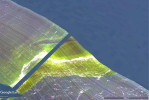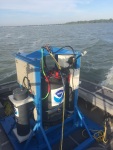Researchers partner with drinking water plant managers to forecast hypoxia in Lake Erie
By Devin Gill, Cooperative Institute for Great Lakes Research and Kristin Schrader, Great Lakes Observation Systems
Lake Erie’s “dead zone” not only impacts the lake’s ecosystem, but also poses challenges for managers of drinking water treatment facilities. The Lake Erie dead zone is a region of the central basin where oxygen levels within the water become extremely low, creating a condition known as hypoxia. Great Lakes researchers are sharing their scientific expertise to help managers be fully prepared for threats to drinking water resulting from hypoxic conditions.
Scientists from NOAA GLERL, Cooperative Institute for Great Lakes Research (CIGLR) and the Great Lakes Observing System (GLOS) met on May 23 in Cleveland, Ohio with water plant managers from the southern shore of Lake Erie for a stakeholder engagement workshop to discuss the hypoxia issue. An important focus of the workshop was the development of a new hypoxia forecast model that will act as an early warning system when hypoxic water has the potential to enter intakes of water treatment facilities. The depletion of oxygen in hypoxic water occurs when the water column stratifies (separates into warm and cold layers that don’t mix). Oxygen in the lower, cold layer becomes depleted from the lack of mixing with the upper (warm) layer that is exposed to air, as well as from the decomposition of organic matter (dead plants and animals) in the lower layer. The process of hypoxia is illustrated by GLERL’s infographic, The Story of Hypoxia.
Stakeholders who attended the workshop explained that water treatment operators must be prepared to respond quickly during a hypoxic event to ensure that drinking water quality standards are met. Hypoxic water often is associated with low pH and elevated manganese and iron. Manganese can cause discoloration of treated water, while low pH may require adjustment to avoid corrosion of water distribution pipes, which can introduce lead and copper into the water.
At the workshop, researchers shared information on lake processes that contribute to hypoxia and on development of the Lake Erie Operational Forecasting System that provides nowcasts and forecasting guidance of water levels, currents, and water temperature out to 120 hours, and is updated 4 times a day. Information was also shared on preliminary hypoxia modeling results that simulated an upwelling event (wind-driven motion in the Great Lakes, pushing cooler water towards the lake surface, replacing the warmer surface water) that brought hypoxic water to several water plant intakes in September, 2016. Water plant managers reported that advance notice of a potential upwelling event that could bring hypoxic water to their intakes would be useful to alert staff and potentially increase the frequency of testing for manganese.
Dr. Mark Rowe from University of Michigan, CIGLR, researcher and co-lead on this initiative, comments on the value of this hypoxia stakeholder engagement workshop: “At both NOAA and the University of Michigan, there is an increasing focus on co-design of research, which refers to involving the end-users of research results throughout the entire project, from concept to conclusion. If we succeed, a new forecast model will be developed that will be run by the operational branch of NOAA. This can only happen if there is a group of users who request it. This workshop provided critical information to the researchers regarding the needs of the water plants, while also informing water plant managers on how forecast models could potentially help them plan their operations, and on the latest scientific understanding of hypoxia in Lake Erie. ”
Stakeholder Scott Moegling, Water Quality Manager at City of Cleveland Division of Water, also recognizes the value of engagement between the stakeholders and the Great Lakes researchers. Moegling points out that “the drinking water plant managers not only benefit from sharing of operational information and research, but also by establishing lines of communication between water utilities and researchers that help identify common areas of interest. The end result—researchers providing products that can be immediately used by water utilities—is of obvious interest to the water treatment industry on Lake Erie.” Moegling also views the GLERL/CIGLR research on the hypoxia forecast model as holding great potential in predicting hypoxic conditions in Lake Erie and believes that once the model is developed and calibrated, there may be a number of other possibilities for highly useful applications.
In addition to sharing the latest research on hypoxia, the stakeholder engagement workshop provided a forum for water plant managers to share information with each other on how to recognize hypoxic events and efficiently adjust water treatment processes. Researchers at CIGLR and NOAA GLERL are committed to conduct research that serves society, and will continue to work with this stakeholder group over the course of the five-year project to develop a hypoxia forecast model that meets their needs.
This slideshow requires JavaScript.














